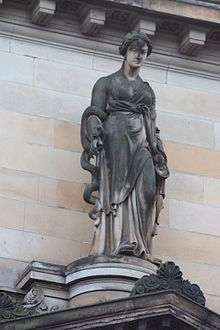Hygieia
In Greek as well as Roman mythology, Hygieia (also Hygiea or Hygeia; Ancient Greek: Ὑγιεία or Ὑγεία, Latin: Hygēa or Hygīa), was one of the Asclepiadae; the sons and daughters of the god of medicine, Asclepius, and his wife Epione. Hygieia was the goddess/personification of health (Greek: ὑγίεια - hugieia[1]), cleanliness and hygiene.
| Hygieia | |
|---|---|
Goddess of good health, cleanliness, and sanitation | |
1st century Roman statue of the goddess | |
| Abode | Mount Olympus |
| Personal information | |
| Parents | Asclepius and Epione |
| Siblings | Iaso, Panacea, Aceso, Aglaea |
| Roman equivalent | Valetudo, Salus |

Hygieia and her four sisters each performed a facet of Apollo's art: Hygieia (health, cleanliness, and sanitation); Panacea (universal remedy); Iaso (recuperation from illness); Aceso (the healing process); and Aglaïa (beauty, splendor, glory, magnificence, and adornment).
Hygieia also played an important part in her father's cult. While her father was more directly associated with healing, she was associated with the prevention of sickness and the continuation of good health. Her name is the source of the word "hygiene".
Hygieia was imported by the Romans as the goddess Valetudo, the goddess of personal health, but in time she started to be increasingly identified with the ancient Italian goddess of social welfare, Salus.
History
At Athens, Hygieia was the subject of a local cult from at least the 7th century BC. "Athena Hygieia" was one of the cult titles given to Athena, as Plutarch recounts of the building of the Parthenon (447–432 BC):
A strange accident happened in the course of building, which showed that the goddess was not averse to the work, but was aiding and co-operating to bring it to perfection. One of the artificers, the quickest and the handiest workman among them all, with a slip of his foot fell down from a great height, and lay in a miserable condition, the physicians having no hope of his recovery. When Pericles was in distress about this, the goddess [Athena] appeared to him at night in a dream, and ordered a course of treatment, which he applied, and in a short time and with great ease cured the man. And upon this occasion it was that he set up a brass statue of Athena Hygieia, in the citadel near the altar, which they say was there before. But it was Phidias who wrought the goddess's image in gold, and he has his name inscribed on the pedestal as the workman of it.[2]
However, the cult of Hygieia as an independent goddess did not begin to spread out until the Delphic oracle recognized her, and after the devastating Plague of Athens (430–427 BC) and in Rome in 293 BC.
In the 2nd century AD, Pausanias noted the statues both of Hygieia and of Athena Hygieia near the entrance to the Acropolis of Athens.[3]
Worship

Hygieia's primary temples were in Epidaurus, Corinth, Cos and Pergamon. Pausanias remarked that, at the Asclepieion of Titane in Sicyon (founded by Alexanor, Asclepius' grandson), statues of Hygieia were covered by women's hair and pieces of Babylonian clothes. According to inscriptions, the same sacrifices were offered at Paros.
Ariphron, a Sicyonian artist from the 4th century BC wrote a well-known hymn celebrating her.[5] Statues of Hygieia were created by Scopas, Bryaxis and Timotheus, among others, but there is no clear description of what they looked like. She was often depicted as a young woman feeding a large snake that was wrapped around her body or drinking from a jar that she carried.[6] These attributes were later adopted by the Gallo-Roman healing goddess, Sirona. Hygieia was accompanied by her brother, Telesphorus.
See also
- Bowl of Hygieia
- 10 Hygiea, a main belt asteroid named after Hygieia
- College of Aesculapius and Hygia
- List of health deities
Notes
- ὑγίεια, Henry George Liddell, Robert Scott, A Greek-English Lexicon, on Perseus
- Plutarch. Life of Pericles 13.8, on-line text.
- Pausanias, I.23.4; the statement in Pliny's Natural History (xxxiv.80) Pyrrhus fecit Hygiam et Minervam has been applied to these statues: see H. B. Walters, "Athena Hygieia", The Journal of Hellenic Studies 19 (1899:165–168) p. 167.
- Allman, George Johnston (1889). Greek Geometry from Thales to Euclid. Hodges, Figgis, & Co. p. 26.
- Athenaeus, Deipnosophists, xv.702, on-line text.
- Similar images, though of a goddess in a more warlike aspect, represent Athena and Erichthonius.
References
- Smith, William; Dictionary of Greek and Roman Biography and Mythology, London (1873). "Hygieia".
External links
- Theoi Project: Hygeia Greek and Latin notices, in translation.
- Chisholm, Hugh, ed. (1911). . Encyclopædia Britannica (11th ed.). Cambridge University Press.